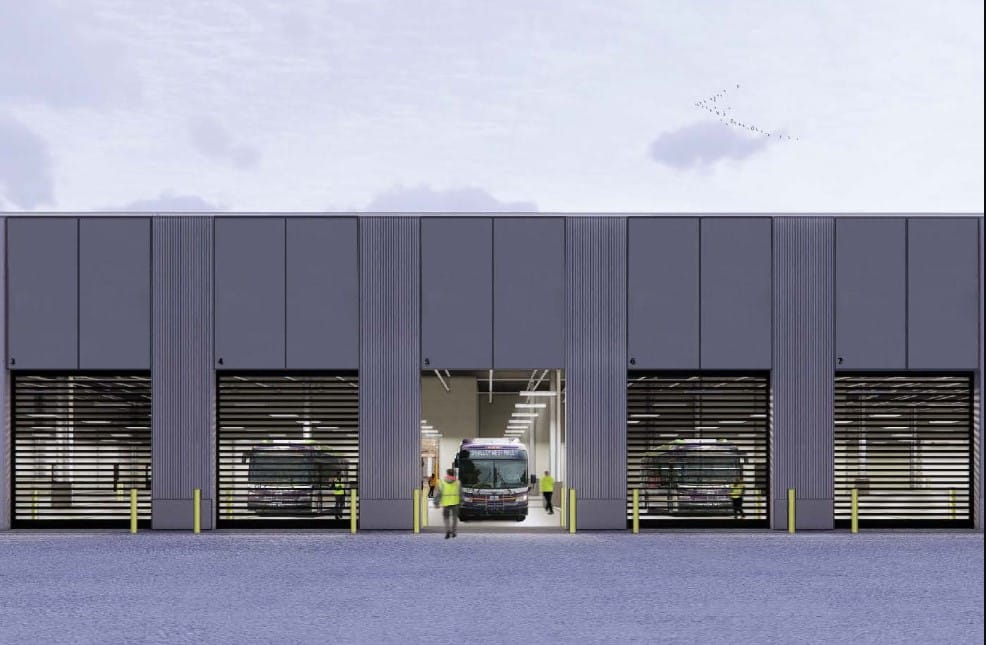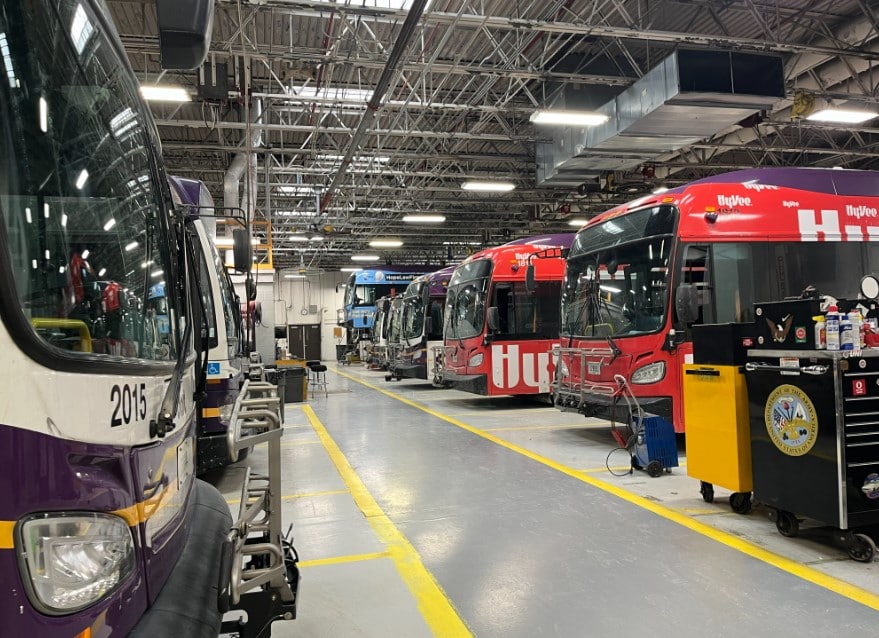DART approves land purchase agreement with city for new facility

Michael Crumb Jan 23, 2024 | 5:01 pm
6 min read time
1,490 wordsAll Latest News, Real Estate and Development, Transportation
Des Moines Area Regional Transit Authority will buy more than 32 acres on Vandalia Road, on the city’s southeast side, to build a new maintenance and operations facility, relocating its operations near downtown Des Moines when the project is complete.
The DART board of commissioners took the next step in that plan Tuesday when it approved a purchase agreement for the property with the city of Des Moines. According to the agreement, DART will pay the city $3.91 million for the land. The agreement is awaiting approval by the Des Moines City Council, which is expected to consider it in March.
Leaders of the transit agency said the relocation of their facilities, currently located off of Southwest Ninth Street, is necessary to improve its long-term operation. Its current site is landlocked in an area of changing use and is in a flood plain, sitting just feet from a levee along the Raccoon River. Dart’s maintenance building has flooded several times over the years when the river rose out of its banks.
Once industrial, the area around DART is now bordered by mixed-use developments of condominiums and retail.
The inability to expand at its current location and being a flood plain makes it unlikely DART would qualify for federal grants to improve the site, making the move critical for the agency to continue to meet the needs of the community, leaders said.
“It is the best use of taxpayer dollars and helps get our buildings in a place that is a better fit than we are right now and helps ensure we can provide future and sustainable service,” Amanda Wanke, DART’s CEO, said in advance of the commission’s vote. “When we’re building a new building, we have to be looking at 50 years from now. And as we look at how technologies are changing, we have to be able to build and be ready to adapt to a variety of new technologies, and there’s not the infrastructure and ability to do that here.”
Wanke said the Federal Transit Administration also has said it won’t put more money into the existing facility because of the challenges the site presents.
“Most capital expenses are paid for by the federal government, and we want to have a facility that is funded as much as possible by the federal side of things and functions well for 50 years, and has the lowest operating costs,” she said.
Luis Montoya, chief planning officer for DART, said the existing facility was built in the 1970s when buses were smaller and when the agency operated fewer of them.

When the current facility was built, it was designed for 100 buses and support vehicles. Today’s DART fleet stands at 168 buses and support vehicles.
The current maintenance shop has 11 bays, which are tight and don’t provide adequate space for mechanics to work on buses. Employees need to repair and change tires outdoors, and the bus wash (similar to a car wash) is exposed to the outdoors and has to be shut down when the temperature drops below 20 degrees to prevent components from icing up, Montoya said.
The body shop is also too tight to get one of today’s buses in for repairs, and bus panels have to be removed in order to be repaired, he said.
There is also a lack of storage for parts and equipment, Montoya said.
According to plans, a new maintenance garage would include 16 bays and provide more space for crews to work. It would also move all repairs indoors and allow for the bus wash to continue operating in colder temperatures.
“In the new facility, it will be indoors, climate controlled and newer equipment,” Montoya said while giving the Business Record a tour of the facility on Monday.
A new facility also would provide more in-house storage for tools, parts and equipment, which currently are stored in various areas on the property.
The garage where buses are stored is also too small for modern buses, forcing operators to get out and fold in mirrors to fit them through the garage doors. It also is being used as overflow storage for parts, such as tires.
The overall project will be done in three phases, with the first phase being the maintenance facility and storage.
“We’re choosing to replace the maintenance building first because that’s going to improve our working conditions,” Montoya said. “And parts, because maintenance and parts have to go together. We don’t have enough space to keep these materials near to where they need to be used. So we have a need for a bigger building so that we can have it all in one place and we’re operating more efficiently.”
That will cost an estimated $34.8 million, with $17.2 million coming from an FTA grant that was awarded in 2019. The remainder would come from a variety of other sources, including local matching funds and capital funding.
The cost of renovating the building would be nearly double that, at about $63 million, and operating the aging structure would only go up, Montoya said.
The Vandalia Road site is southeast of the state fairgrounds in an area that will have access to the Southeast Connector project when that is extended to the U.S. Highway 65 bypass in the future. Improvements to 36th Street are also planned, Montoya said.
The decision to relocate its facilities comes as DART continues to discuss funding challenges that could result in service cuts.
Wanke said the funding formulas are different for capital improvements and operations, and DART risks losing the 2019 grant if it doesn’t make progress on the project because of deadlines tied to the grant.
Most capital expenses are funded with 80% federal dollars and 20% local money. Funding for operations is flipped, with the vast majority of operations being funded locally, she said.
“So that’s why these are two separate conversations, and even if we do have to reduce service, we know that as a region, we’re growing and we have to plan for 50 years,” she said. “We know our local taxpayers expect us to be good stewards, and the commission and us have looked at this. It’s the right thing to do because we have federal money we risk losing if we don’t move forward on this, and we’d drive up our operating costs with the challenges of trying to maintain this facility because the federal government won’t put money into this facility.”
DART first began exploring the option of relocating in 2017. The board of commissioners voted in September to move forward with phase one of the project.
Once the City Council approves the agreement, DART will issue requests for proposals this summer. Construction of phase one is scheduled to be complete in 2026.
The second phase of the project is the bus storage building and operations and administration. The third phase will be additional storage.
Wanke said the second and third phases — estimated to cost $40 million and $20 million, respectively — will be done when funding is available.
DART will apply for a federal bus and facilities grant in the next few months and will continue to explore other funding options for those phases, she said.
Wanke said moving forward with the project that will be funded by the grant awarded in 2019 could increase DART’s chances of securing other federal dollars for the project.
“We do know that [the FTA] has been clear that making progress and showing local commitment to progress will hopefully be helpful to us,” she said.
Montoya said it’s difficult to speculate when that funding could be available to move forward with the other phases of the project.
“We’re preparing ourselves that it could be years,” he said. “That’s why we’re building this most needed piece first. We have a plan for how that will operate in the meantime. It will be an improvement. Just building phase one will be a huge improvement, and we’re setting ourselves up for success for later phases.”
DART commission Chair Russ Trimble said during the meeting that there’s “no doubt” that relocating and building new is the right decision.
“The more you see the old facility, the more discussions you have about being in a flood plain, having to take apart buses to be able to paint them and all the issues we have, FTA saying they’re not going to put any more funding toward this,” he said. “There’s no doubt in my mind this is the right way to go.”

Michael Crumb
Michael Crumb is a senior staff writer at Business Record. He covers real estate and development and transportation.










